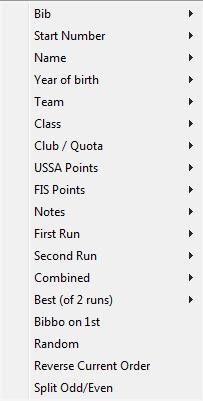National FIS Software : Competitors Sort: Difference between revisions
| Line 34: | Line 34: | ||
====Is it truly Random?==== | ====Is it truly Random?==== | ||
Technically, no, it's ' | Technically, no, it's 'pseudorandom'. But, the argument can easily be made that for this application pseudorandom is random enough. | ||
For those interested here's | Websters Dictionary defines pseudorandom as: | ||
::"being or involving entities (as numbers) that are selected by a definite computational process but that satisfy one or more standard tests for statistical randomness" | |||
For those interested here's the details on the Random Sorting process used by Split Second Software: | |||
Revision as of 22:32, 12 August 2009
Overview
Clicking on Sort will give a list of possible sort options, often with sub-options for Ascending and Descending. The list will vary depending on the settings on the Header Tab.

Under most situations you won’t need to use the sort options. Whenever a report is generated it will sort the competitors into the correct order.
If the order it creates is not correct or you have a special situation that needs a particular order this can be achieved as follows:
- In the Edit|Options menu uncheck the ‘Automatically Sort when needed’ option. When this is unchecked it will give a prompt any time it would normally sort, giving you the option to accept the default sort or not.
- Using the sort options (with or without a block marked) and possibly the Move option get the competitors into the order needed.
- Print the report. When it prompts to ‘Sort ?’ answer ‘N’
- NOTE: In the event of more than one competitor having the same value for a sort option the original order is maintained. For example, if you sort by Time and then sort by Class you'll end up with the Competitors sorted by Time within Class. This can be very useful!
Random Sorting
Questions often come up regarding random sorting.
Only Random Sort Once!
Never sort until you like the result! If you were doing a double blind draw in a team captains meeting and the resulting start order happened to be the same as the original order on the board, or if all competitors from the same nation raced first, you wouldn't do the draw again because that's a legitimate result of random sorting.
It's so quick and simple to do a random sort using the software that it may become tempting to do it again if the result seems unusual or coincidental.
Resist! Only sort once and accept whatever you get!
Is it truly Random?
Technically, no, it's 'pseudorandom'. But, the argument can easily be made that for this application pseudorandom is random enough.
Websters Dictionary defines pseudorandom as:
- "being or involving entities (as numbers) that are selected by a definite computational process but that satisfy one or more standard tests for statistical randomness"
For those interested here's the details on the Random Sorting process used by Split Second Software: